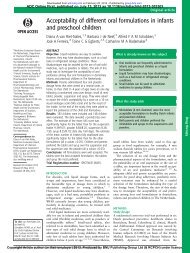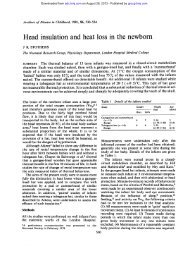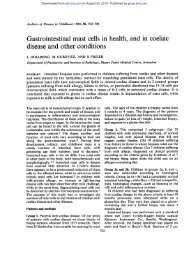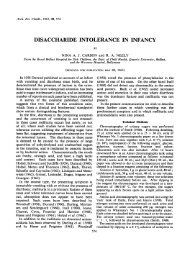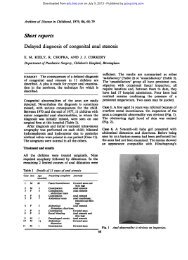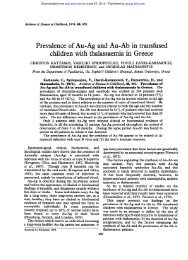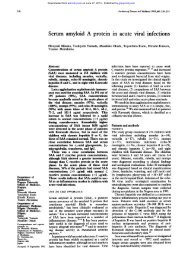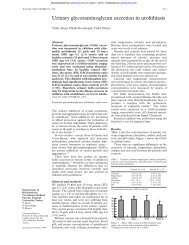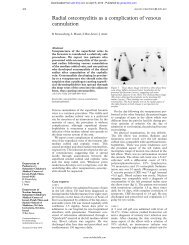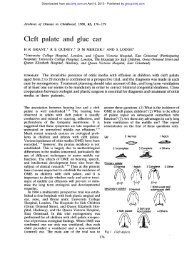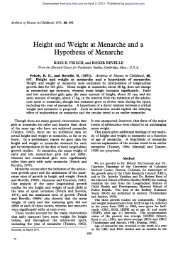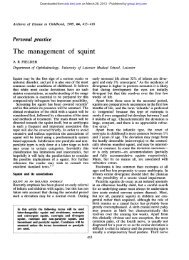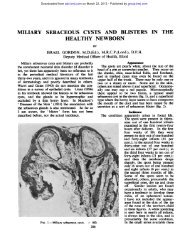Planning for major incidents involving children by ... - BMJ
Planning for major incidents involving children by ... - BMJ
Planning for major incidents involving children by ... - BMJ
Create successful ePaper yourself
Turn your PDF publications into a flip-book with our unique Google optimized e-Paper software.
Downloaded from<br />
adc.bmj.com on December 24, 2012 - Published <strong>by</strong> group.bmj.com<br />
<strong>Planning</strong> <strong>for</strong> <strong>major</strong> <strong>incidents</strong> <strong>by</strong> implementing a Delphi study 411<br />
Table 3 Paediatric coordinator action card<br />
Responsibilities<br />
Overall control of the paediatric response<br />
StaYng of senior key appointments<br />
Liaison with tertiary hospitals regarding the need <strong>for</strong> specialist paediatric teams, personnel, or equipment<br />
Ensuring that a safe level of provision is maintained <strong>for</strong> current inpatients<br />
Control of the phasing of the stand down of the hospital paediatric response<br />
Coordination of post-traumatic counselling of <strong>children</strong> and staV<br />
Immediate action<br />
Assume control of the paediatric aspects of the hospital response<br />
Ensure that the following post is filled:<br />
senior nurse–<strong>children</strong><br />
if not filled then appoint a suitably senior member in the interim<br />
Liaise with the medical coordinator, the senior nurse–<strong>children</strong>, and the senior manager regarding the state of<br />
preparedness of the hospital to receive <strong>children</strong>, and the initial availability of appropriate staV<br />
Liaise with coordinators of the <strong>major</strong> incident responses in other receiving hospitals, to ascertain the initial<br />
requirements <strong>for</strong> paediatric teams, specialist personnel, and equipment<br />
Instruct consultant paediatric staV who are not already included in the plan as they arrive<br />
Continually liaise with the following senior key personnel:<br />
medical coordinator<br />
senior nurse–<strong>children</strong><br />
senior manager<br />
to receive reports on the situation as it develops, and to review the eVect of the <strong>major</strong> incident response on<br />
the normal activities of the hospital<br />
Decide at an early stage any limitations on normal hospital activities<br />
Liaise with the senior manager regarding an initial press release<br />
As the incident develops ensure that adequate arrangements are made <strong>for</strong> shift working to allow adequate rest <strong>for</strong> staV<br />
As the surgical response develops liaise with the duty consultant surgeon and the duty consultant anaesthetist to<br />
ascertain the current availability of surgical resources<br />
Liaise with senior key personnel regarding how to stand down the hospital response<br />
Liaise with the appropriate services regarding provision of post-traumatic counselling of <strong>major</strong> incident casualties<br />
admitted to the hospital, and of staV involved in the <strong>major</strong> incident response<br />
Priorities<br />
Overall coordination of the paediatric response<br />
Liaison with other receiving hospital coordinators regarding paediatric requirements<br />
Monitoring and limitation of normal hospital paediatric activities<br />
Liaison with the specialist anaesthetists and surgeons regarding the paediatric surgical response<br />
Coordination of the phasing of the stand down<br />
Coordination of post-traumatic counselling <strong>for</strong> <strong>children</strong> and staV<br />
TRAINING<br />
All clinicians involved in the paediatric clinical<br />
response should be trained at least to the level<br />
of advanced paediatric life support (APLS)<br />
provider. 4 In addition, those involved in managing<br />
the response and all who might be involved<br />
in the prehospital response should be trained in<br />
<strong>major</strong> incident management to the level of <strong>major</strong><br />
incident medical management and support<br />
(MIMMS) provider 5 or equivalent.<br />
Medical management<br />
Medical management includes command and<br />
control of the response, safety aspects, communications,<br />
and assessment. Only the command<br />
of the response will diVer when <strong>children</strong> are<br />
involved.<br />
COMMAND<br />
Children will be dispatched to hospital <strong>by</strong> the<br />
ambulance and medical incident oYcers at the<br />
Table 4 Paediatric assessment team action card<br />
scene, and transported to hospital <strong>by</strong> the<br />
ambulance service. All hospitals that might<br />
receive <strong>children</strong> should appoint a paediatric<br />
coordinator to assist the hospital coordination<br />
team in managing them and overseeing their<br />
care. Table 3 shows an action card <strong>for</strong> the paediatric<br />
coordinator.<br />
Some specialist paediatric resources and<br />
services are limited so decisions must be made<br />
about which patients need them most. These<br />
scarce resources are most likely to be found at<br />
<strong>children</strong>’s hospitals, which must there<strong>for</strong>e be<br />
central to the decisions about how patients are<br />
allocated. Where there is no specialist <strong>children</strong>’s<br />
hospital, those housing the specialist<br />
services must nominate a lead hospital. Deciding<br />
on resource allocation will be much more<br />
diYcult if <strong>children</strong> are dispersed around many<br />
receiving hospitals. To in<strong>for</strong>m the decision<br />
making process, lead paediatric units must be<br />
Responsibilities<br />
Estimate total number of <strong>children</strong> in receiving hospitals who may need paediatric tertiary services<br />
Liaison with paediatric specialist services to ascertain the level of provision available<br />
Identify individual <strong>children</strong> suitable <strong>for</strong> transfer to tertiary services<br />
Liaise with paediatric coordinators in receiving hospitals to arrange transfer<br />
Immediate action<br />
Proceed to lead paediatric hospital and report to the paediatric coordinator<br />
Liaise with the paediatric coordinator to ascertain the number of <strong>children</strong> likely to be involved, the<br />
number of receiving hospitals, and the paediatric specialist services that may be required<br />
Liaise with the relevant specialist paediatric services to ascertain preparedness and level of provision available<br />
Proceed to the receiving units and liaise with the local paediatric coordinator to ascertain the number of<br />
<strong>children</strong> (if any) who need specialist provision<br />
Estimate the relative need of each child <strong>for</strong> specialist provision<br />
Match availability with need in each receiving unit<br />
Arrange transfer of <strong>children</strong> who can be dealt with in the specialist units<br />
Ensure that specialist units and receiving hospital staV have liaised regarding <strong>children</strong> who have not been transferred<br />
Priorities<br />
Estimation of the availability of specialist services<br />
Estimation of the need <strong>for</strong> each specialist service within each receiving unit<br />
Matching need with availability



